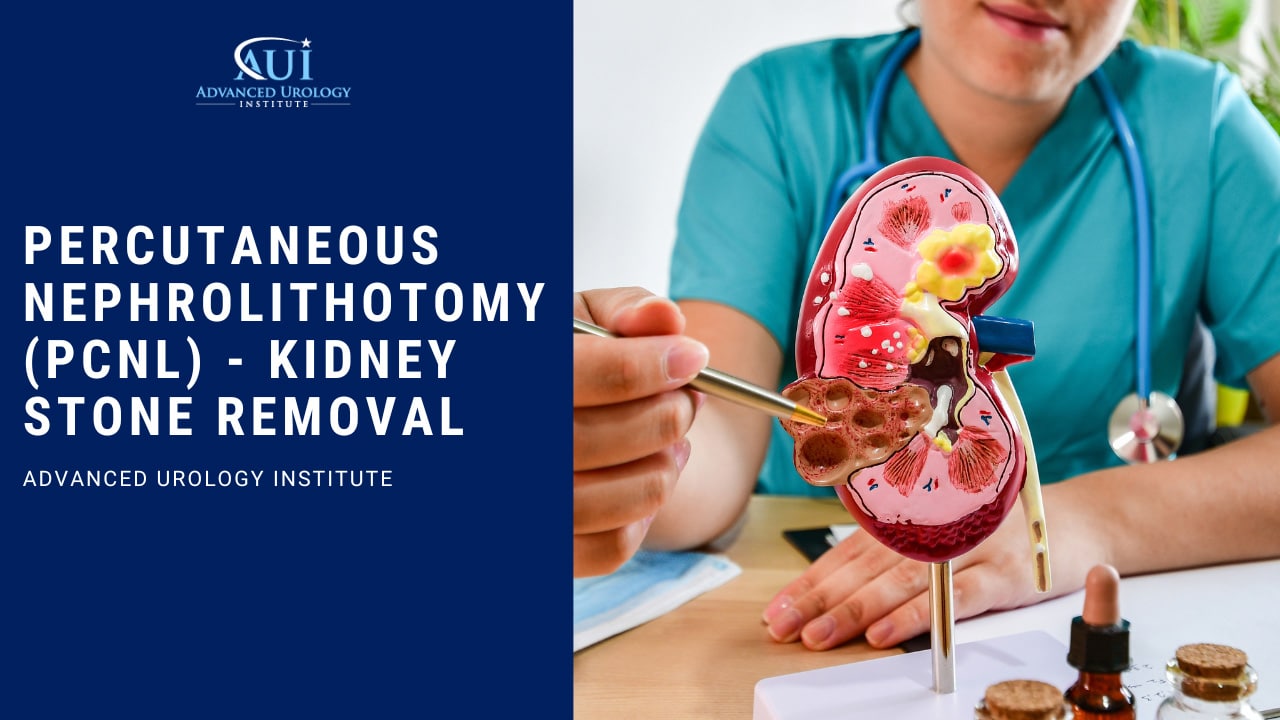Percutaneous Nephrolithotomy (PCNL) – Kidney Stone Removal
3 Key Takeaways:
- Percutaneous Nephrolithotomy (PCNL) is a revolutionary kidney stone removal technique for removing larger kidney stones (two centimeters or more) that cannot be effectively addressed with simple procedures or shockwave lithotripsy.
- PCNL involves making a small incision in the back to access the kidney and break up the stone, eliminating the need for open stone surgery.
- PCNL is a minimally invasive procedure that allows patients to resume their daily activities sooner than traditional surgery and can be performed at the Advanced Urology Institute without the need to go to a tertiary care center.
https://www.youtube.com/watch?v=ru_HgRXMIk0
 “There are unfortunately some stones too large to pass after a shockwave lithotripsy. But with percutaneous stone removal or PCNL, stones can be effectively removed, providing relief to the patients,” Dr. Michael Jenkins, a urologist in Panama City, Florida, informed us.
“There are unfortunately some stones too large to pass after a shockwave lithotripsy. But with percutaneous stone removal or PCNL, stones can be effectively removed, providing relief to the patients,” Dr. Michael Jenkins, a urologist in Panama City, Florida, informed us.
Kidney stones tend to be a painful condition that can disrupt a person’s life. Yet, advancements in urology now lead to better treatment solutions, employing minimally invasive and advanced techniques to effectively address these issues. One such development in the sphere of kidney stone treatment is the Percutaneous Nephrolithotomy (PCNL).
Understanding PCNL
PCNL, a critical aspect of urology, is the method of addressing larger kidney stones, usually two centimeters or more. Simple procedures or those involving a shockwave often prove ineffective in dealing with such large stones.
Dr. Samuel Lawindy, a urologist in Port Orange, Florida, explains, “PCNL, or long-term as percutaneous nephrolithotripsy, works very well in these cases. The procedure goes through the back of the kidney directly to where the stone is situated. We break it up and safely pull out those pieces.”
The Procedure
This technique requires placing a small tube through the back that’s somewhat larger than those typically used in procedures conducted from below. This tube aids in fragmenting the stones from the back. Though it’s slightly more invasive, it still involves a small incision. More importantly, it removes the need for open stone surgery, a significant benefit to the patient.
What to Expect during the Kidney Stone Removal
Undergoing PCNL involves a single overnight stay at the hospital. Patients can usually return home the very next day, and the procedure is generally well-tolerated. By employing this method of kidney stone removal, patients can expect to resume their daily activities much sooner than traditional surgery.
“The fact that it is a good option for patients with large kidney stones is important to note. We offer this procedure right here in our facility – there’s no need to go to a tertiary care center,” Dr. Lawindy added.
Experience Professional Care at Advanced Urology Institute
At the Advanced Urology Institute, we are dedicated to providing top-quality care for kidney stone sufferers. With professional urologists located in different parts of Florida, including Panama City and Port Orange, we bring the expertise and experience required to confidently deal with kidney stone treatment.
Our dedicated team of specialists is well-equipped to handle a variety of urologic conditions. We take a minimally invasive route wherever feasible to ensure a faster recovery time, lesser discomfort, and minimum hospital stays, with PCNL being a shining example of such an approach.
We are proud to be the largest urology practice in Florida, offering state-of-the-art treatment options for kidney stone removal. Our commitment to comprehensive and compassionate urologic care has led us to be a trusted destination for a wide range of urologic health concerns. Why settle for less, when you can experience excellent care at the Advanced Urology Institute?
References:
- “Treatment for Kidney Stones – NIDDK.” https://www.niddk.nih.gov/health-information/urologic-diseases/kidney-stones/treatment.
- “Treating Kidney Stones: Open Surgery | Saint Luke’s Health System.” https://www.saintlukeskc.org/health-library/treating-kidney-stones-open-surgery.
- “Primary, Secondary, Tertiary, and Quaternary Care – Verywell Health.” 2 Oct. 2022, https://www.verywellhealth.com/primary-secondary-tertiary-and-quaternary-care-2615354.
Transcription:
Dr. Michael Jenkins (Panama City, FL)
One of my other areas of interest is percutaneous stone removal. There are unfortunately some stones that are too large to be removed with a small fiber optic scope and too large to pass after a shockwave lithotripsy.
We still don’t like to do open stone surgery if we have to, so stones can be removed, what’s called percutaneously and that’s placing a small tube through the back that’s a little bit larger than what would typically come in from down below and we’re able to fragment the stones through the back. It’s a bit more invasive but it’s still a small incision.
Dr. Samuel Lawindy (Port Orange, FL)
So PCNL is a very important aspect of urology to understand as the stone can be so large that it’s not going to be treated with just a simple procedure from below or a shockwave. So if you have a large stone in the kidney, usually two centimeters or larger, minimally invasive procedures such as uteroscopy or shockwave will not work.
So a PCNL or long-term as percutaneous nephrolithotripsy would work very well for that. That is where the procedure goes through the back of the kidney directly to where the stone is and we can break it up and pull those pieces out safely and it’s a one night overnight stay at the hospital and you go home the very next day and usually patients tolerate it very well.
It’s a good option for patients who have that stone. It’s important to recognize that it is done here and does not require a tertiary care center. We do take care of it here in this facility.

